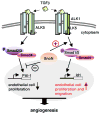SnoN in regulation of embryonic development and tissue morphogenesis
- PMID: 22710172
- PMCID: PMC3897277
- DOI: 10.1016/j.febslet.2012.03.005
SnoN in regulation of embryonic development and tissue morphogenesis
Abstract
SnoN (Ski-novel protein) plays an important role in embryonic development, tumorigenesis and aging. Past studies largely focused on its roles in tumorigenesis. Recent studies of its expression patterns and functions in mouse models and mammalian cells have revealed that SnoN interacts with multiple signaling molecules at different cellular levels to modulate the activities of several signaling pathways in a tissue context and developmental stage dependent manner. These studies suggest that SnoN may have broad functions in the embryonic development and tissue morphogenesis.
Copyright © 2012 Federation of European Biochemical Societies. All rights reserved.
Figures


Similar articles
-
SnoN signaling in proliferating cells and postmitotic neurons.FEBS Lett. 2012 Jul 4;586(14):1977-83. doi: 10.1016/j.febslet.2012.02.048. Epub 2012 Mar 8. FEBS Lett. 2012. PMID: 22710173 Free PMC article. Review.
-
Ski and SnoN: negative regulators of TGF-beta signaling.Curr Opin Genet Dev. 2004 Feb;14(1):65-70. doi: 10.1016/j.gde.2003.11.003. Curr Opin Genet Dev. 2004. PMID: 15108807 Review.
-
Oncogene and tumour suppressor: the two faces of SnoN.EMBO J. 2009 Nov 18;28(22):3459-60. doi: 10.1038/emboj.2009.311. EMBO J. 2009. PMID: 19920850 Free PMC article.
-
Transforming growth factor-beta regulator SnoN modulates mammary gland branching morphogenesis, postlactational involution, and mammary tumorigenesis.Cancer Res. 2010 May 15;70(10):4204-13. doi: 10.1158/0008-5472.CAN-10-0135. Epub 2010 May 11. Cancer Res. 2010. PMID: 20460516 Free PMC article.
-
SnoN in mammalian development, function and diseases.Curr Opin Pharmacol. 2010 Dec;10(6):670-5. doi: 10.1016/j.coph.2010.08.006. Epub 2010 Sep 6. Curr Opin Pharmacol. 2010. PMID: 20822955 Free PMC article. Review.
Cited by
-
The regulatory protein SnoN antagonizes activin/Smad2 protein signaling and thereby promotes adipocyte differentiation and obesity in mice.J Biol Chem. 2018 Sep 7;293(36):14100-14111. doi: 10.1074/jbc.RA118.003678. Epub 2018 Jul 20. J Biol Chem. 2018. PMID: 30030373 Free PMC article.
-
The SMAD2/3 corepressor SNON maintains pluripotency through selective repression of mesendodermal genes in human ES cells.Genes Dev. 2012 Nov 15;26(22):2471-6. doi: 10.1101/gad.201772.112. Genes Dev. 2012. PMID: 23154981 Free PMC article.
-
SnoN Antagonizes the Hippo Kinase Complex to Promote TAZ Signaling during Breast Carcinogenesis.Dev Cell. 2016 Jun 6;37(5):399-412. doi: 10.1016/j.devcel.2016.05.002. Epub 2016 May 26. Dev Cell. 2016. PMID: 27237790 Free PMC article.
-
Regulation of transforming growth factor-β signalling by SUMOylation and its role in fibrosis.Open Biol. 2021 Nov;11(11):210043. doi: 10.1098/rsob.210043. Epub 2021 Nov 10. Open Biol. 2021. PMID: 34753319 Free PMC article.
-
CORL Expression in the Drosophila Central Nervous System Is Regulated by Stage Specific Interactions of Intertwined Activators and Repressors.G3 (Bethesda). 2018 Jul 2;8(7):2527-2536. doi: 10.1534/g3.118.200282. G3 (Bethesda). 2018. PMID: 29848623 Free PMC article.
References
-
- Boyer PL, Colmenares C, Stavnezer E, Hughes SH. Sequence and biological activity of chicken snoN cDNA clones. Oncogene. 1993;8:457–466. - PubMed
-
- Pelzer T, Lyons GE, Kim S, Moreadith RW. Cloning and characterization of the murine homolog of the sno proto-oncogene reveals a novel splice variant. Dev Dyn. 1996;205:114–125. - PubMed

